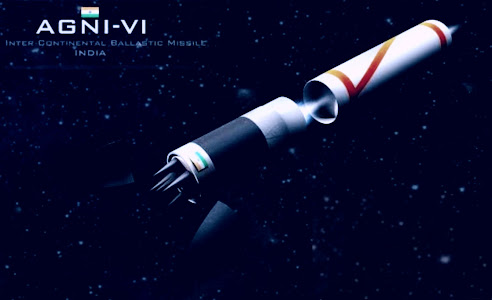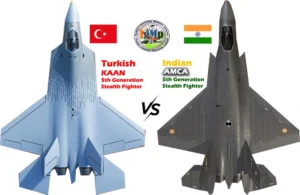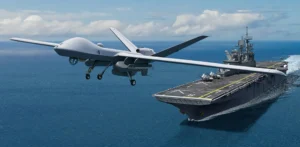 |
| Artistic Rendering of Agni-VI ICBM |
In January 2018, India tested the Agni-V missile, capping its official range to 5,000 km, a figure beyond which it would be called an Intercontinental Ballistic Missile (ICBM). Unofficially, the range of the Agni-V missile was quoted by analysts as more than 5000 km and would be able to hit the most significant cities on the territory of India’s main geopolitical rival China, including Beijing, Guangzhou, Shanghai and Hong Kong. But, the officials explained that any missile could have an extended range with a lesser payload, better navigation and requires testing. They said the 5000 km range was officially the “confidence level”, meaning that the missile may not perform as designed beyond the range. This also meant India had not officially crossed the Intermediate Range Ballistic Missile (IRBM) range threshold.
To date, India is armed with four types of missiles of the Agni series and has two other models in testing. The deployed models include Agni-1 with a range of 700 kilometres, Agni-II with a range of 2 thousand kilometres, Agni-III and Agni-IV with a range of 2.5 thousand to 3.5 thousand kilometres, respectively. Agni Prime (Agni-P) is a new generation missile under testing. It is expected that Agni P Agni-V will go into service after the test or may have been deployed, as there is no confirmation.
Soon after the Agni-V test, VK Saraswat, the then Defence Research and Development Organisation (DRDO) chief, said India was not ready to cap the Agni program.
In 2013, Saraswat said the Agni-IV was in the making, and the hardware was being readied. He said increasing the range was the least challenging task. No official range was given but was estimated to be about 8000 to 10,000 km.
The missile program was called the Surya Missile program, but there was no official acknowledgement of the nomenclature.
The current Russian special operations in Ukraine show how the lone superpower, the U.S, can be restrained by Russia, a country the current U.S. President Joe Biden explained does not want to be an ‘Upper Volta’ with nuclear weapons. The war also shows how China has maintained an independent stance toward the conflict in the face of U.S. coercion. Both have nuclear missiles pointed at the northern American country.
The lessons have not escaped India. It could test or at least ready the Agni-VI missile as a technology demonstrator in the coming three years and validate the computer simulations.
Another reason to test Agni-VI is to hit the farthest corners of China from a safer and survivable distance within the Indian territory.
DRDO personnel have always maintained that they are constantly engaged in researching the newer technologies, including more contemporary materials, better navigation and a more extended range. If the government of the day calls for a newer missile, they would be ready to do so, but the government specifies the range and payload.
As per the current estimates, the Agni-VI missile has a confidence range of up to 10,000 kilometres. In addition, the possibility of launching from a submarine is also being developed. The Indian SSBNs would be able to hit their targets further than the current missiles, which have a limited range. The SSBNs are not expected to leave the security dragnet of the Indian territorial waters.
Officials related to such development in India told Frontier India that the country currently has every technology to counter immediate threats and will develop every technology required for future threat prospective.
The source told Frontier India that the government would officially not admit the Agni-VI program because it currently shares good relations with many countries. Several bilateral and multilateral projects are on. Foreign policy is on new heights, and the country’s influence is increasing day by day on international platforms. At this rising point in time, no country will officially accept the existence of such a developing missile which can target every ally and partner nation.
But unofficially Agni-VI project is on track, and India has already developed many critical technologies required for this missile, and partially we have demonstrated them as well.
The source said that Agni-VI missile has two unique features, a range of more than 10,000 km, and it carries MIRV capability (multiple independently targetable re-entry vehicles). MIRVs are independent munitions carried by a single missile that can be used to attack single or multiple targets.
If one can put the payload at the desirable location on Mars. Then it is apparent that it can also put the warhead at any desirable location on earth, he said.
He said the missile would be available to menace India’s adversaries sooner.
It is for the second time in its history that India is trying to develop an ICBM. In the 1970s, India initiated developing an ICBM under the project Valiant under the Defence Research and Development Laboratory (DRDL). The project was terminated, and the liquid fuelled engine developed was rejected by the Indian Space Research Organisation (ISRO) for the reason that the Valiant project was not well managed, and as a civilian organisation, ISRO did not want to cooperate with a sanction-prone military research organisation.






